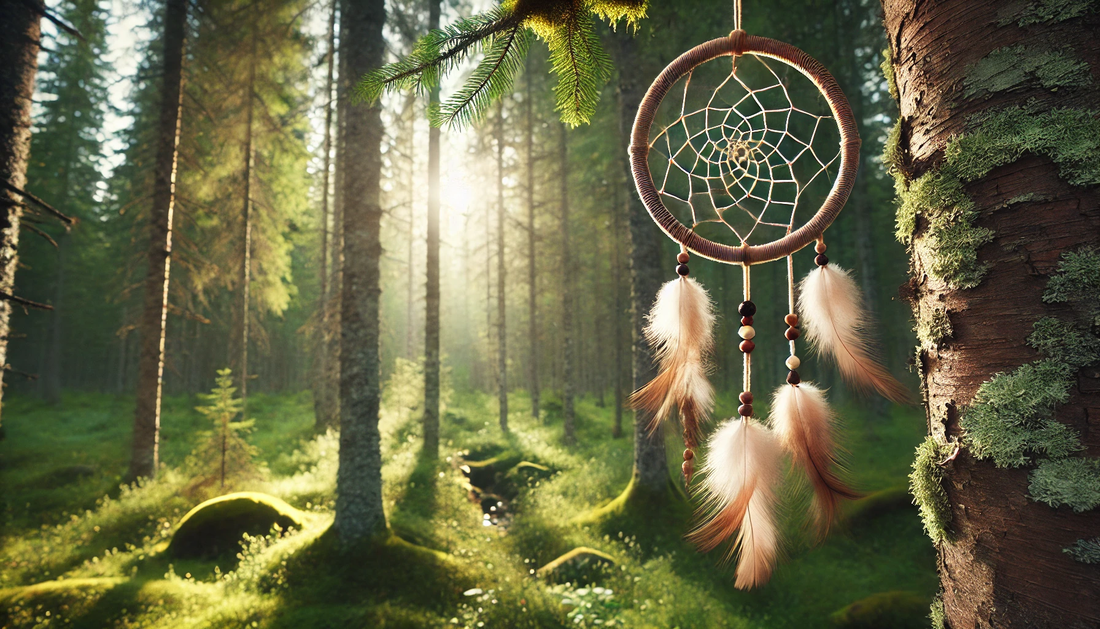
The Dreamcatcher: Meaning and Function in Indigenous Traditions
Share
The dream catcher, often called a dreamcatcher , has become an iconic object in indigenous cultures. More than just a decoration, this object is loaded with spiritual meanings and is used to protect sleepers from bad dreams. In this article, we will explore how the dream catcher works and the symbolism surrounding this traditional object.
Origins of the dream catcher
The dreamcatcher originated in the Ojibwe and Lakota cultures, although its use spread to other indigenous peoples of North America. According to Ojibwe legends, the “spider woman” ( Asibikaashi ) watched over the people, especially the children. Over time, families dispersed, and it became difficult for her to protect all members of the community. So she passed on the art of making dreamcatchers to protect children while they slept.

Spiritual functioning of the dream catcher
The dreamcatcher works as a spiritual filter. Here's how it's supposed to work at night:
1. Trapping Bad Dreams
The dreamcatcher is hung above the bed, usually in the bedroom, to catch dreams that are circulating in the air. Bad dreams are caught in the central net. This net, similar to a spider web, traps these unwanted dreams and prevents them from passing to the sleeper.
2. Destroy Bad Dreams at Sunrise
The first rays of the sun destroy the bad dreams caught in the net. That is why the dreamcatcher is placed so that it receives the morning light, ensuring that the negative dreams dissipate at daybreak.
3. Let the good dreams pass
Good dreams, bringing wisdom, peace or positive visions, pass through the net without hindrance. They slide along the suspended feathers to the sleeping person, bringing benevolent thoughts and energies. This gentle transmission helps the sleeper feel rested and protected.
The symbolism of the elements of the dream catcher
Each element of the dreamcatcher has a particular meaning that reinforces its spiritual power:
• The Hoop : It is often made of willow wood and represents the cycle of life and the universe. The circle is an important symbol in many indigenous cultures, representing harmony and interconnection between all living things.
• The net : the central weave, inspired by a spider's web, symbolizes protection and the ability to filter energies. The net catches bad dreams, preventing them from passing to the sleeper.
• Feathers : Feathers, attached to the bottom of the dreamcatcher, symbolize air or the breath of life. They allow good dreams to gently glide to the sleeping person, also representing gentleness and peace.
• Beads and other decorations : In some dream catchers, beads or stones are added to enhance protection and aesthetics. Each bead can represent a trapped dream or different aspects of life.
A spiritual protection and a symbol of identity
Beyond their protective function, dreamcatchers are also symbols of cultural identity for many Indigenous peoples. They embody a connection with ancestors and spiritual beliefs, and are often passed down from generation to generation. The dreamcatcher, in addition to its role in protection during sleep, recalls the richness and diversity of Indigenous cultures.
Modern Use of Dream Catchers
Today, dreamcatchers are used far beyond Indigenous communities and have become popular in many homes. However, it is important to respect their origin and cultural significance. Using a dreamcatcher is also a way of recognizing and honoring Indigenous traditions.
Conclusion
The dreamcatcher is much more than just a decorative object. In Indigenous traditions, it is a powerful symbol of protection, wisdom and spiritual connection. By placing it above your bed, you bring a part of this rich and ancestral culture into your home, while benefiting from protection against bad dreams. Whether or not you believe in its spiritual power, the dreamcatcher reminds us of the importance of preserving and valuing Indigenous traditions.
Sources and references
1. History and significance of dreamcatchers in Ojibwe culture.
2. Indigenous legends and traditions associated with spiritual objects.
3. Testimonies and explanations from indigenous elders on the use of dream catchers.
This article will help you better understand the dreamcatcher and its role in Indigenous spirituality. If you are interested in learning more about cultural symbols and objects, explore our collection of crafts on Indigenous Crafts and delve into the fascinating world of Indigenous traditions.














